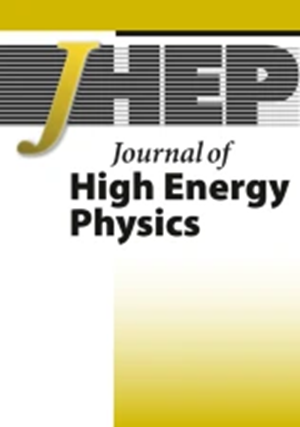4D IIB通量真空与超对称破缺。第二部分。玻色子谱和稳定性
IF 5.5
1区 物理与天体物理
Q1 PHYSICS, PARTICLES & FIELDS
引用次数: 5
摘要
我们最近构造了依赖于一个附加坐标的四维iib型紧化,其中在一个内环面上的五形式通量Φ导致了恒定的弦耦合。当内部流形包含一个有限长度的区间,该区间由一个保形坐标在有限范围0 &lt内张成时,超对称被完全破缺;Z & Z;zm。本文研究了低空玻色子谱及其经典稳定性,特别注意了自伴随边界条件。特殊的边界条件导致零模态的出现,而零模态是由一阶方程精确确定的。光谱的不同扇区可以用有限区间上的Schrödinger算符表示,其特征是实常数μ和$$ \overset{\sim }{\mu } $$ μ对,在任何情况下μ都等于1/3或2/3,$$ \overset{\sim }{\mu } $$ μ的值不同。电势在末端处表现为$$ \frac{\mu^2-1/4}{z^2} $$ μ 2−1 / 4 z2和$$ \frac{{\overset{\sim }{\mu}}^2-1/4}{{\left({z}_m-z\right)}^2} $$ μ 2−1 / 4 zm−z2,可以用精确可解的三角函数来近似。随着内部动量的消失,人们因此可以识别出范围广泛的边界条件,尽管在某些领域出现了复杂性。对于非单重态矢量和标量的Kaluza-Klein激励,Schrödinger系统的场对和依赖于背景的稳定区域随着Φ/ l4的减小而变宽。本文章由计算机程序翻译,如有差异,请以英文原文为准。
A 4D IIB flux vacuum and supersymmetry breaking. Part II. Bosonic spectrum and stability
A bstract We recently constructed type-IIB compactifications to four dimensions depending on a single additional coordinate, where a five-form flux Φ on an internal torus leads to a constant string coupling. Supersymmetry is fully broken when the internal manifold includes a finite interval of length ℓ , which is spanned by a conformal coordinate in a finite range 0 < z < z m . Here we examine the low-lying bosonic spectra and their classical stability, paying special attention to self-adjoint boundary conditions. Special boundary conditions result in the emergence of zero modes, which are determined exactly by first-order equations. The different sectors of the spectrum can be related to Schrödinger operators on a finite interval, characterized by pairs of real constants μ and $$ \overset{\sim }{\mu } $$ μ ~ , with μ equal to 1/3 or 2/3 in all cases and different values of $$ \overset{\sim }{\mu } $$ μ ~ . The potentials behave as $$ \frac{\mu^2-1/4}{z^2} $$ μ 2 − 1 / 4 z 2 and $$ \frac{{\overset{\sim }{\mu}}^2-1/4}{{\left({z}_m-z\right)}^2} $$ μ ~ 2 − 1 / 4 z m − z 2 near the ends and can be closely approximated by exactly solvable trigonometric ones. With vanishing internal momenta, one can thus identify a wide range of boundary conditions granting perturbative stability, despite the intricacies that emerge in some sectors. For the Kaluza-Klein excitations of non-singlet vectors and scalars the Schrödinger systems couple pairs of fields, and the stability regions, which depend on the background, widen as the ratio Φ/ ℓ 4 decreases.
求助全文
通过发布文献求助,成功后即可免费获取论文全文。
去求助
来源期刊

Journal of High Energy Physics
PHYSICS, PARTICLES & FIELDS-
CiteScore
10.00
自引率
46.30%
发文量
2107
审稿时长
12 weeks
期刊介绍:
The aim of the Journal of High Energy Physics (JHEP) is to ensure fast and efficient online publication tools to the scientific community, while keeping that community in charge of every aspect of the peer-review and publication process in order to ensure the highest quality standards in the journal.
Consequently, the Advisory and Editorial Boards, composed of distinguished, active scientists in the field, jointly establish with the Scientific Director the journal''s scientific policy and ensure the scientific quality of accepted articles.
JHEP presently encompasses the following areas of theoretical and experimental physics:
Collider Physics
Underground and Large Array Physics
Quantum Field Theory
Gauge Field Theories
Symmetries
String and Brane Theory
General Relativity and Gravitation
Supersymmetry
Mathematical Methods of Physics
Mostly Solvable Models
Astroparticles
Statistical Field Theories
Mostly Weak Interactions
Mostly Strong Interactions
Quantum Field Theory (phenomenology)
Strings and Branes
Phenomenological Aspects of Supersymmetry
Mostly Strong Interactions (phenomenology).
 求助内容:
求助内容: 应助结果提醒方式:
应助结果提醒方式:


